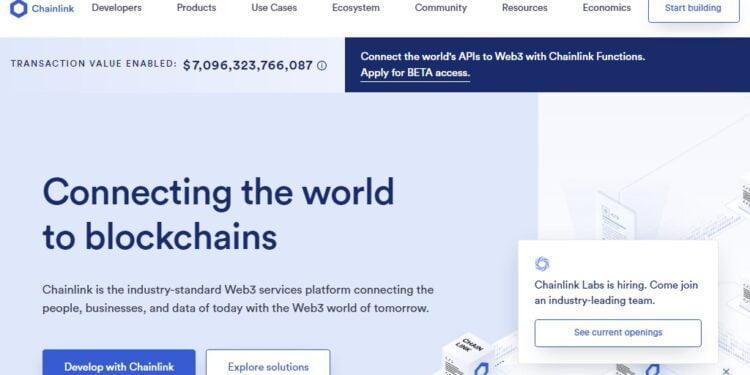Chainlink is a decentralized oracle network that provides reliable and secure access to external data sources and APIs (Application Programming Interfaces) for smart contracts running on blockchain platforms.
Smart contracts are self-executing contracts with the terms of the agreement between buyer and seller being directly written into code and executed on a blockchain. However, smart contracts are currently limited to the data that is available within the blockchain, and they cannot directly access external data sources, such as market data, weather reports, or other off-chain information.
Chainlink solves this problem by acting as a middleware between the smart contract and the off-chain data source, providing a secure and decentralized way to retrieve and verify external data. Chainlink uses a decentralized network of nodes (known as “oracles”) to connect to the external data source, retrieve the data, and feed it back to the smart contract in a secure and tamper-proof manner.
Chainlink’s unique features include its ability to aggregate data from multiple sources to ensure accuracy and reliability, its ability to provide on-chain data verification and dispute resolution, and its support for various blockchain platforms, including Ethereum, Bitcoin, and Binance Smart Chain. The LINK token is the native cryptocurrency used to pay for Chainlink services and incentivize node operators.
What Is Chainlink Mobile Wallet?
Chainlink does not have a mobile wallet of its own, as it is not a cryptocurrency or blockchain platform itself. Instead, Chainlink is a decentralized oracle network that provides data to smart contracts on blockchain platforms.
However, there are mobile wallets that support the LINK token, which is the native cryptocurrency of the Chainlink network. Some examples of mobile wallets that support LINK include Trust Wallet, Ledger Live, and Atomic Wallet. These wallets allow users to store, send, and receive LINK tokens, as well as other cryptocurrencies, on their mobile devices.
Using a mobile wallet that supports LINK, users can also interact with Chainlink-enabled smart contracts on supported blockchain platforms, such as Ethereum, by sending and receiving LINK tokens as payment for oracle services. However, it is important to note that mobile wallets, like all cryptocurrency wallets, should be used with caution and proper security measures, such as enabling two-factor authentication and keeping private keys safe and secure.
Why Chainlink Mobile Wallets Important?
Mobile wallets that support Chainlink’s native cryptocurrency, LINK, are important for several reasons:
- Convenience: Mobile wallets allow users to store, send, and receive LINK tokens on-the-go, without the need for a desktop computer or hardware wallet. This can be particularly useful for users who need to make quick transactions or access their LINK tokens while away from their computer.
- Access to Chainlink–enabled services: By using a mobile wallet that supports LINK, users can interact with Chainlink-enabled smart contracts on supported blockchain platforms, such as Ethereum, from their mobile device. This can open up new use cases for smart contracts, such as mobile payments and decentralized finance (DeFi) applications.
- Security: Mobile wallets can provide a secure way to store and manage cryptocurrencies, including LINK. Many mobile wallets use advanced security features, such as two-factor authentication, biometric authentication, and encryption, to protect user funds from theft or hacking.
- User adoption: As more users adopt mobile wallets that support LINK, it can help to increase the overall adoption and use of the Chainlink network. This can lead to more demand for oracle services, which can help to increase the value of the LINK token.
Overall, mobile wallets that support LINK are an important tool for users who want to store, send, and receive LINK tokens, as well as interact with Chainlink-enabled smart contracts from their mobile device. However, as with all cryptocurrency wallets, it is important to use proper security measures and exercise caution when managing funds.
Best Chainlink Mobile Wallets (LINK Mobile Wallets)
There are several Chainlink mobile wallets available in the market, each with its own unique features and advantages. Here are some of the best Chainlink mobile wallets:
Ledger Nano X.
Ledger Nano X is a hardware cryptocurrency wallet developed by Ledger, a French company that specializes in blockchain security solutions. It was released in 2019 and is the successor to the Ledger Nano S.
The Ledger Nano X is a small device that connects to your computer or mobile device using Bluetooth or a USB cable. It stores your private keys offline and provides an extra layer of security by requiring physical confirmation for transactions to be processed.
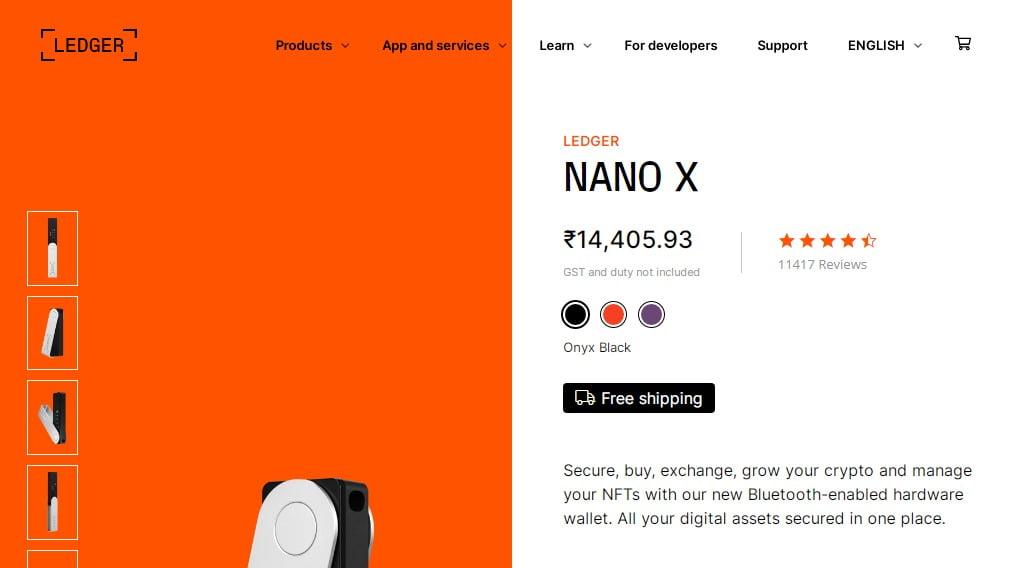
The device supports over 1,800 cryptocurrencies and is compatible with most operating systems including Windows, Mac, Linux, iOS, and Android. It also comes with a built-in rechargeable battery and a large memory capacity, making it a convenient option for storing multiple cryptocurrencies.
Overall, the Ledger Nano X is a popular and reliable hardware wallet for cryptocurrency users who want to store their digital assets in a secure and convenient manner.
Trezor Model T
Trezor Model T is a hardware wallet for cryptocurrencies developed by Satoshi Labs, a Czech Republic-based company that specializes in blockchain security solutions. It was first released in 2018 and is an upgraded version of the original Trezor One.
The Trezor Model T is a small device that connects to your computer or mobile device using a USB cable. It stores your private keys offline and provides an extra layer of security by requiring physical confirmation for transactions to be processed.
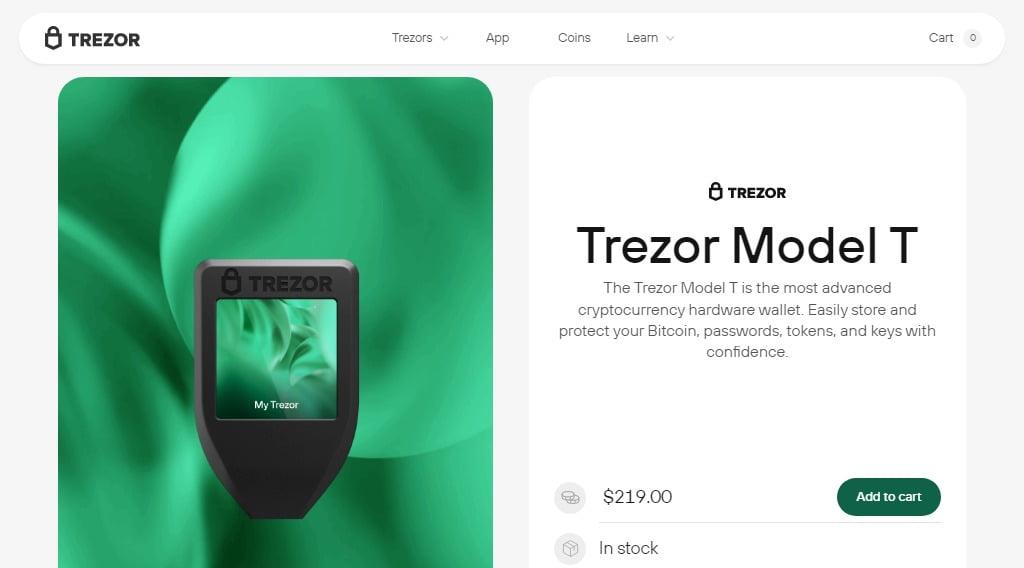
The device supports over 1,000 cryptocurrencies and is compatible with most operating systems including Windows, Mac, Linux, iOS, and Android. It also features a full-color touchscreen and a faster processor than the original Trezor One, making it more user-friendly and convenient to use.
In addition to storing cryptocurrencies, the Trezor Model T can also be used for secure password management, two-factor authentication, and even as a U2F hardware token for Google and Dropbox.
Overall, the Trezor Model T is a popular and reliable hardware wallet for cryptocurrency users who want to store their digital assets in a secure and convenient manner.
Metamask
MetaMask is a browser extension that serves as a cryptocurrency wallet and an Ethereum decentralized application (dApp) browser. It was created by ConsenSys, a blockchain technology company, in 2016.
MetaMask allows users to store, manage, and interact with Ethereum-based cryptocurrencies and dApps directly from their web browser without needing to download a separate wallet or application. It is available as a browser extension for Chrome, Firefox, Opera, and Brave.
With MetaMask, users can create multiple Ethereum accounts, view their account balances and transaction history, and send and receive Ethereum and ERC-20 tokens. It also allows users to connect to Ethereum-based dApps and interact with them securely, without exposing their private keys.
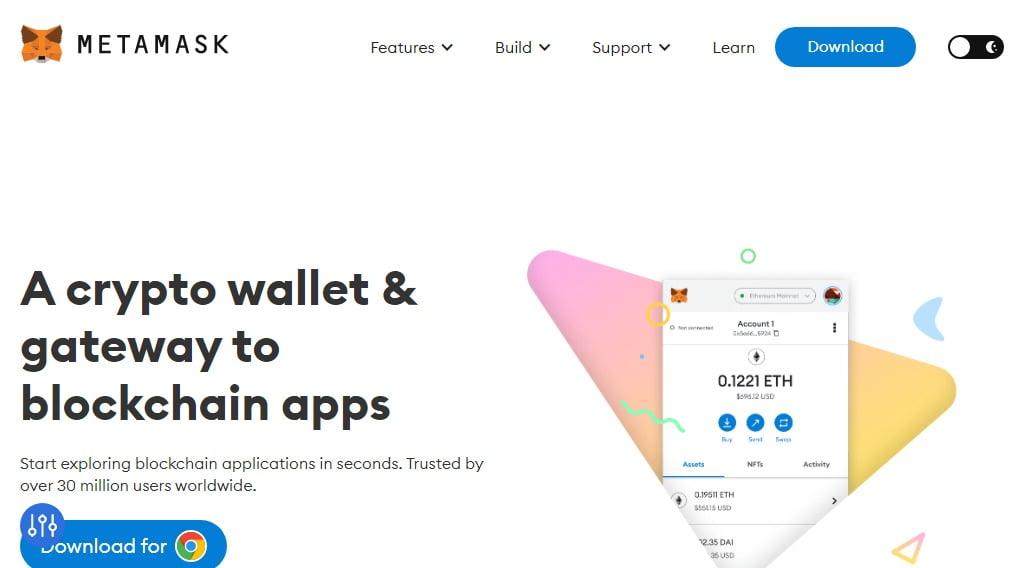
MetaMask also provides users with a convenient way to access and manage their decentralized finance (DeFi) assets, such as lending and borrowing platforms, decentralized exchanges (DEXs), and yield farming protocols.
Overall, MetaMask has become a popular choice for Ethereum users who want to interact with the Ethereum ecosystem and access decentralized applications directly from their web browser.
Coinomi
Coinomi is a multi-currency software wallet that supports over 1,700 cryptocurrencies and tokens. It was launched in 2014 and is available for download on Windows, Mac, Linux, iOS, and Android devices.
Coinomi allows users to securely store, manage, and exchange cryptocurrencies through its user-friendly interface. It uses strong encryption and offers features such as seed phrase backup, two-factor authentication, and support for multiple languages.
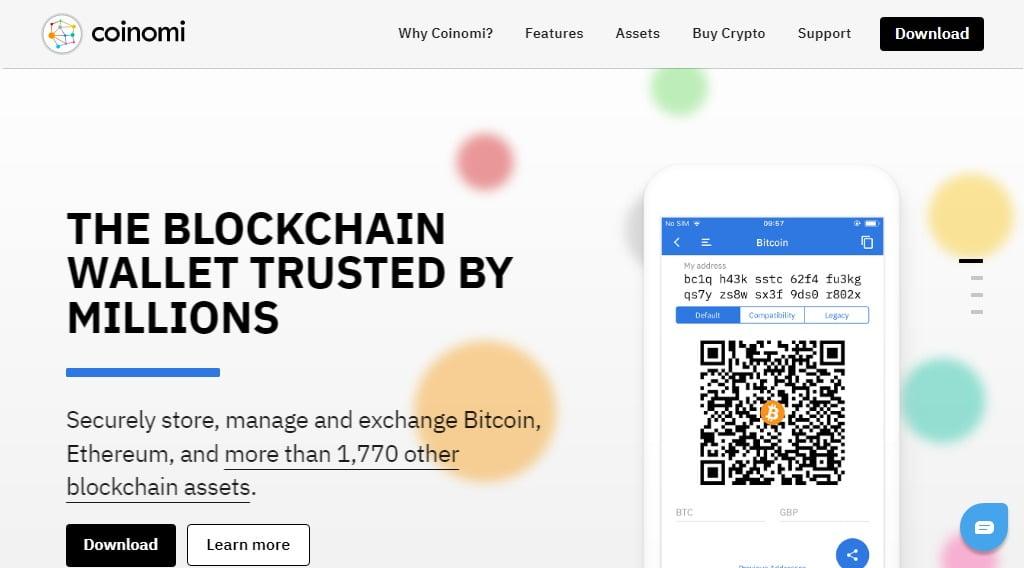
Coinomi’s built-in exchange feature allows users to trade between cryptocurrencies without needing to use an external exchange. The wallet also supports integration with hardware wallets such as Trezor and Ledger for added security.
One of the unique features of Coinomi is its support for anonymous transactions through its integration with the Tor network. This allows users to maintain their privacy and anonymity when transacting with cryptocurrencies.
Overall, Coinomi is a popular choice for cryptocurrency users who want a secure and easy-to-use wallet that supports a wide range of cryptocurrencies and tokens.
How To Setup Your Chainlink Mobile Wallet?
Here are the general steps to set up your Chainlink mobile wallet:
- Download the Chainlink wallet app from the App Store (iOS) or Google Play Store (Android) and install it on your mobile device.
- Open the app and click on “Create New Wallet” to start setting up a new wallet.
- Choose a secure password and confirm it. Make sure to use a strong and unique password and store it securely.
- Write down your seed phrase and store it securely. This seed phrase is used to restore access to your wallet in case you forget your password or lose your device. Make sure to keep it private and never share it with anyone.
- Verify your seed phrase by selecting the words in the correct order as displayed on the screen.
- Your Chainlink wallet is now created, and you can start using it to send and receive LINK tokens.
- To receive LINK tokens, click on the “Receive” tab and copy your wallet address. You can share this address with anyone who wants to send you LINK tokens.
- To send LINK tokens, click on the “Send” tab and enter the recipient’s wallet address and the amount of LINK you want to send. Review the transaction details and confirm the transaction.
- You can also use the “Swap” tab to swap between different cryptocurrencies and tokens directly within the app.
Make sure to keep your mobile device and your wallet app updated with the latest software and security patches to maintain the security of your Chainlink mobile wallet.
How To Secure Your Chainlink Mobile Wallet?
Here are some general tips on how to secure your Chainlink mobile wallet:
- Set a strong password: Choose a strong and unique password for your wallet and don’t share it with anyone. Use a combination of letters, numbers, and special characters.
- Enable two-factor authentication: Many mobile wallets, including Chainlink, offer two-factor authentication (2FA) as an additional layer of security. This requires a code generated by an authentication app to be entered along with your password to access your wallet.
- Backup your seed phrase: Write down your seed phrase and store it in a secure location, such as a fireproof safe or a safety deposit box. Do not store it digitally, as this increases the risk of it being stolen.
- Keep your mobile device secure: Use a strong password or PIN to lock your mobile device, and avoid downloading apps from untrusted sources. Also, make sure to keep your device’s operating system and apps up-to-date with the latest security patches.
- Use a hardware wallet: Consider using a hardware wallet, such as a Ledger Nano or Trezor, for storing large amounts of LINK tokens. This provides an additional layer of security as the private keys are stored offline on the hardware device.
- Be cautious with public Wi-Fi: Avoid accessing your Chainlink mobile wallet on public Wi-Fi networks as they can be easily compromised. Use a secure and trusted Wi-Fi network or cellular data instead.
By following these tips, you can help ensure the security of your Chainlink mobile wallet and protect your LINK tokens from potential theft or loss.
How To Transfer & Receive Chainlink From Mobile Wallet ?
Here are the general steps to transfer and receive Chainlink (LINK) from your Chainlink mobile wallet:
To transfer Chainlink:
- Open your Chainlink mobile wallet app and enter your password or use your biometric login if available.
- Click on the “Send” button.
- Enter the amount of Chainlink you want to send and the recipient’s wallet address.
- Review the transaction details and confirm the transaction.
- Wait for the transaction to be confirmed on the blockchain. This can take a few minutes or longer depending on network congestion.
To receive Chainlink:
- Open your Chainlink mobile wallet app and click on the “Receive” button.
- Share your wallet address with the sender. They can copy and paste it, or scan the QR code.
- Wait for the Chainlink to arrive in your wallet. The transaction will be confirmed on the blockchain, which may take a few minutes or longer.
It is important to verify the wallet address with the recipient before sending any Chainlink to ensure that you are sending it to the correct wallet. Always double-check the wallet address and transaction details before sending any funds to avoid any errors or losses.
Also, be aware of the current network fees for Chainlink transactions, as they can fluctuate based on network congestion. You may want to consider adjusting the fee to ensure that the transaction is processed quickly and efficiently.
Chainlink Mobile Wallet Conclusion
In conclusion, the Chainlink mobile wallet is a convenient and secure way to store and manage your LINK tokens on-the-go. With the ability to transfer and receive Chainlink quickly and easily, the mobile wallet is a great tool for those who need access to their funds on a regular basis.
To ensure the security of your Chainlink mobile wallet, it is important to follow best practices such as setting a strong password, enabling two-factor authentication, and keeping your mobile device secure. It is also recommended to backup your seed phrase in a secure location and consider using a hardware wallet for storing large amounts of LINK.
By taking these precautions, you can help protect your LINK tokens from potential theft or loss and enjoy the benefits of using the Chainlink mobile wallet for managing your cryptocurrency assets.
Chainlink Frequently Asked Questions
What is Chainlink?
Chainlink is a decentralized oracle network that connects smart contracts to real-world data and events. It aims to solve the problem of trust in smart contracts by providing a secure and reliable way to access off-chain data.
What is an oracle?
An oracle is a third-party service that provides data to a smart contract. In the context of Chainlink, oracles are decentralized nodes that fetch data from off-chain sources and deliver it to smart contracts.
What is LINK?
LINK is the native cryptocurrency of the Chainlink network. It is used to pay for the services of the Chainlink nodes and to incentivize the creation of new nodes.
How can I store LINK?
You can store LINK in a variety of cryptocurrency wallets, including hardware wallets, desktop wallets, and mobile wallets. Some popular options include Ledger Nano, Trezor, MetaMask, and the official Chainlink mobile wallet.
What is staking?
Staking is the process of holding cryptocurrency to support the security and operation of a blockchain network. In the context of Chainlink, staking involves locking up LINK tokens as collateral to secure the oracle network and earn rewards.
